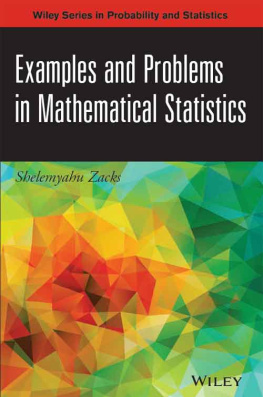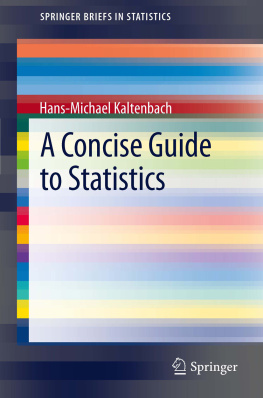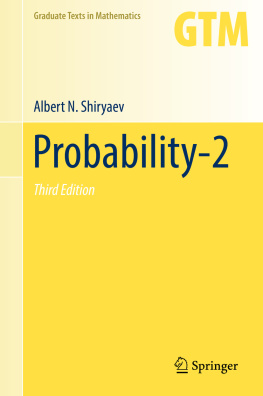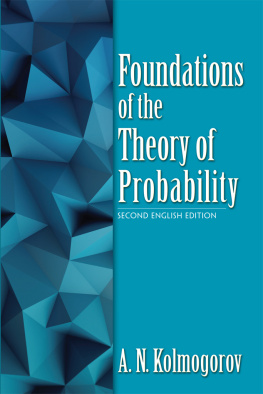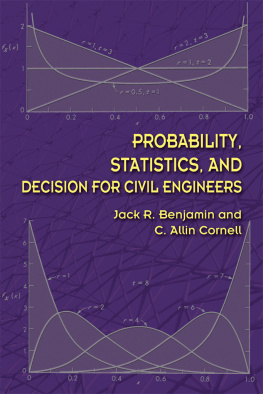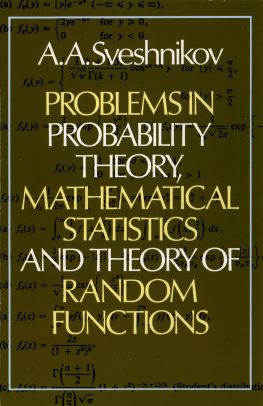Fundamentals of
Statistics & Probability Theory
A Tutorial Approach
Vol. 1 Probability Theory
Howard Dachslager, Ph.D.
Irvine Valley College
PATHWAYS TO CLEAR LEARNING
Learning Step by Step
FUNDAMENTALS OF
Statistics
&
Probability Theory
A Tutorial Approach
Vol. 1 Probability Theory
Howard Dachslager, Ph.D.
Copyright 2012 by Howard Dachslager.
All rights reserved. Except as permitted under the Copyright Act of 1976, no part of this publication may be reproduced or distributed in any form or by any means, or stored in a database or retrieval system, without the prior written permission of the publisher, with the exception that the program listings may be entered, stored, and executed in a computer system, but they may not be reproduced for publication. Published in the United States of American.
Published by
Path Ways To Clear Learning
Telephone (949) 375-1675
Web Site: PathwaysToClearLearning.com
E-Mail address:
ISBN: 978-1492245100
To My Dearest Friends
Frankie Besch & Albert Murtz
Table Of Contents
VOLUME I PROBABILITY THEORY
VOLUME II STATISTICS
Inference Theory
Lesson 28 The Central Limit Theorem
Lesson 29 Estimating the Mean of a Population
Lesson 30 Statistical Hypotheses
Lesson 31 Hypothesis Testing
Lesson 32 Type I Error
Lesson 33 Type II Error
Lesson 34 Combining Type I and Type II Errors
Lesson 35 The Distribution of P
Lesson 36 Estimating The Proportion p of a Population
Lesson 37 Decision Theory Using P
Lesson 38 The Distribution of Differences of Sample Means
Lesson 39 The Distribution of Differences of Sample
Lesson 40 Small Sampling Theory
Lesson 41 The F Distribution
Lesson 42 Analysis of Variance
Lesson 43 The Chi-Square Distribution
Lesson 44 Correlation and Regression Analysis I
Lesson 45 Correlation and Regression Analysis II
Lesson 46 Non parametric Statistics
TABLE C The Standard Normal Distribution
TABLE D The t-Distribution table
TABLE E F - Distribution
TABLE F The Chi-Square Distribution
Appendix A Review Frequency Distributions
Appendix B Review Averages
Appendix C Review Measuring Variation
Appendix D Review The Standard Normal Distribution
Complete solutions to all unsolved problems and supplementary problems are in
the web site: http://www.PathwaysToClearLearning.com
Brevity is the soul of wit
William Shakespeare
Hamlet Act 2, Scene 2
Preface
How to Use this Book
This book is designed to tutor the reader in a first course study of statistics and probability theory. It covers all the major topics. Each topic is covered by several lessons. For each lesson, the reader is presented with exercises as examples and problems. For each example, its solution is worked out step by step in detail. Following the examples, solved problems that mimic the examples are also worked out in similar detail. Finally to test the readers understanding, unsolved problems that mimic the examples as well as the solved problems are presented with answers. At the end of each lesson, a set of supplementary problems is given. These problems are more challenging then those in the main body of the tutorial. Detailed solutions of the unsolved problems and supplementary problems can be found in the solution manual.
To see how the tutorial works, let us look at a section of this book. In the book, turn to page 47, (copied below). We see that this example comes with a solution.
Next go to the bottom of page 47 for (copied below). We see that this example comes with a solution (top of page 48).
Note that are same type of problems and have the same type of solutions.
Next go to page 48 for . The line
Refer back to .
reminds the reader to go back to to help in solving the unsolved problem.
Throughout the entire book we use this tutorial method for each example and associated problems.
Why Study Statistics?
Statistics is used to bring meaningful relationships between data and events. The subject can be divided into three areas of study:
Descriptive Statistics
Probability Theory
Inference Theory
We begin this discussion, using examples, to show what statistics can do and finish with examples to show what statistics cannot do.
What Statistics Can Do.
Descriptive Statistics
The application of descriptive statistics to data is extensively used in data collection and applications.
Example: Ms Smith teaches a class in Ancient Greek history at a local senior center. To get a better understanding of her students, she has them fill out a questionnaire about their personal and academic background. Questions such as the students age, gender, income, and academic background are asked. This information will be organized in a way to give Ms. Smith a better understanding of her students.
Example: Mr. Fuente is the track coach at a local high school. At the beginning of each academic year, he has several male and female students try out for the varsity teams. To qualify, the students first need to complete a background questionnaire of themselves and make several runs on the track to determine their speed and endurance at different distances. All the information about the students is collected, organized and evaluated. From this data, students will be selected to participate on the varsity team.
Probability Theory
The tools of probability theory can be used to show and interpret interesting relationships between several events.
Example: On the evening weather news, it was reported that there is a 60 percent chance that it will rain over the weekend. Several questions can be raised about this forecast:
1. How did this number come about?
2. What exactly does 60 percent mean?
Probability theory will help in answering these types of questions.
Example: Mr. Jones is playing a card game. His hand has one king. To win he needs to draw two more kings. What are his chances?
Questions like this are not hard to answer when tools of probability theory are properly applied.
Example: According to a recent study, 7.0% of the population has a lung disease. Of those people that have lung disease, 90% smoke. Suppose a person who smokes is selected at random from the population. Can we conclude that there is a 90% chance that he or she will have a lung disease?
Most people would conclude there is a 90% chance or at least a very high chance that the person selected will have a lung disease. Proper use of probability theory will show this not to be the case. In fact one can show the chance is significantly less than 90%.
Inference Theory
Inference theory is nothing more than drawing certain conclusions about a large population from samples taken from this population. Perhaps proper application of inference theory is the most important discipline of statistics.
Example: The president of a local chamber of commerce wants to find out the opinions of Orange county residents on the building of a new shopping center. Since asking all the residents is not possible, he takes a sample of 200 residents at random and finds that 52% would support the new shopping center. From this poll several questions could be raised:
1. Can he conclude from the results of the sample that 52% of all residents are in support of a new shopping center?



